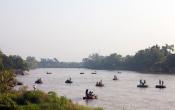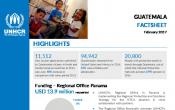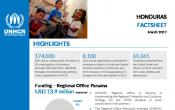Panama Regional Office
The UNHCR's Regional Office in Panama covers operations in Cuba, El Salvador, Guatemala, Honduras and Nicaragua.
Operation: Panama Regional Office
Location
{"longitude":-80,"latitude":8,"zoom_level":0}
Latest update of camps and office locations 21 Nov 2016. By clicking on the icons on the map, additional information is displayed.
Key Figures
| 2016 end-year results | |
| 2,700 | people in transit with international protection needs were assisted in Guatemala |
| 1,960 | refugees and asylum-seekers received legal assistance in Panama |
| 1,400 | IDPs and deportees with protection needs were assisted in Honduras |
| 17 | community-based infrastructure projects in the NTCA countries were supported |
| 2017 planning figures | |
| 65% | of people of concern for whom disaggregated data will be available |
| 4,000 | children and adolescents with protection needs reached through the “Education in Emergencies” project |
| 1,000 | people of concern will receive legal assistance |
| 800 | individuals at heightened protection risk with imminent fear for their lives, due to direct threats, sexual assaults, persecution, forced recruitment and extreme intimidation, will be supported |
| 80 | events, workshops and seminars on law and policy, internal displacement, refugee law and child protection will be organized |
| 70 | partner and Government staff will be provided with general training on child protection and children’s rights |
Latest Updates and Related Links
People of Concern
10%
Increase in
2016
2016
| 2016 | 235,707 |
| 2015 | 214,190 |
| 2014 | 19,663 |

[["Refugees",3358],["Refugee-like situation",15000],["Asylum-seekers",4845],["IDPs",174000],["Stateless",3],["Others of concern",38501]]
Loading ...
Panama Regional Office
< Back
2016
{"categories":[2012,2013,2014,2015,2016,2017],"budget":[5.12996089,5.8548486,8.42523081,8.225381364,16.64769407,22.67219369],"expenditure":[3.74483435,4.03032947,4.45055113,4.39118839,9.23860236,null]}
{"categories":[2012,2013,2014,2015,2016,2017],"p1":[5.12996089,5.69669732,8.10063207,8.225381364,16.64769407,22.67219369],"p2":[null,0.15815128,0.32459874,null,null,null],"p3":[null,null,null,null,null,null],"p4":[null,null,null,null,null,null]}
{"categories":[2012,2013,2014,2015,2016,2017],"p1":[3.74483435,3.87217783,4.28218306,4.39118839,9.23860236,null],"p2":[null,0.15815164,0.16836807,null,null,null],"p3":[null,null,null,null,null,null],"p4":[null,null,null,null,null,null]}
Loading ...
CHOOSE A YEAR
- 2015
- 2016
- 2017
Working environment
Ongoing displacement in the Northern Triangle of Central America (NTCA) has multiple causes including violence and insecurity. NTCA citizens have traditionally sought international protection in the United States of America and Canada. However, in 2016 there was a very significant increase in the number of asylum-seekers from the NTCA in Belize, Costa Rica, Mexico, Nicaragua, and Panama.With the exception of Honduras, data on internal displacement due to violence in the NTCA remains fragmented.
Population trends
- More than 73,000 new asylum applications were made by NTCA nationals in the region, 33 per cent higher than in 2015.
- In Honduras, 174,000 people are internally displaced.
- Approximately 214,000 NTCA citizens were deported in 2016 (mainly from the United States and Mexico) including many with international protection needs.
Achievements and impact
- Refugee recognition rates of people fleeing from the NTCA was increased from 28 per cent in 2011 to an average of 53 per cent in the first half of 2016.
- The IDP profiling exercise was carried out in partnership with the Government of El Salvador (results will be finalized in 2017).
- Regional cooperation was fostered between countries of origin, transit and destination through the San Jose Action Statement.
Unmet needs
-
Update of the IDP profiling in Honduras could not be completed due to lack of resources.
- Limited effective solutions were attained for people of concern as a result of reduced resettlement options, lack of local integration alternatives, and limited livelihoods support, among other factors.
- Protection networks, including safe spaces, could not be expanded in El Salvador, Guatemala and Honduras.
UNHCR’s Regional Office in Panama covers activities in Panama, the Northern Triangle of Central America (Honduras, El Salvador and Guatemala) and Cuba.
Operational context and population trends
In December 2014, at a ministerial meeting in Brasilia, UNHCR and representatives of 28 countries and three territories in Latin America and the Caribbean adopted the Brazil Plan of Action, a road map to address new displacement trends and end statelessness by 2024. This road map aims to guide policy and strategy related to forced displacement, transnational criminal groups, access to and quality of RSD, durable solutions, mixed migration movements, and statelessness.In the Northern Triangle of Central America (NTCA), transnational organized crime and rampant violence continue to pose a major challenge to democratic governance. Criminal activity, fuelled by drug trafficking, weak law enforcement, poverty and unemployment, are also exacerbating the current protection crisis.
Population trends in Central America have changed dramatically in the last years, creating a particularly challenging environment in the NTCA. In 2014 alone, 29,024 requests for asylum were presented worldwide from citizens of NTCA countries.
According to the latest figures made available by migration authorities in 2014, more than 226, 377 people from Central America were deported. This represents a 78% rise in the number of individuals deported between 2011 and 2014. Many have left their countries due to a variety of reasons, including migration; however the Office has noted an increase in the number of people whose lives are at risk and are consequently in need of international protection. In studies such as Children on the Run and Arrancados de Raíz, at least 48% of the unaccompanied children and adolescents interviewed have indicated that they fled their countries due to violence and are therefore in need of international protection.
In Honduras, the Government officially launched an IDP profiling report in November 2015, which revealed that between 2004 and 2014, close to 41,000 households (around 174,000 individuals) in Honduras were affected by internal displacement due to violence and insecurity.
A similar profiling exercise is foreseen in El Salvador to measure the magnitude of forced displacement in the country.
In Panama, UNHCR assisted 2,369 people in 2014, an increasing number of which were asylum-seekers coming from the NTCA.
In Cuba, the refugee population originates mainly from Western Sahara and is projected to make-up 69% of the total in 2015.
Key priorities in 2016
In line with the Brazil Plan of Action, UNHCR’s priorities in 2016 are to:- Support countries of origin in designing and implementing legal frameworks and national policies.
- Establish protection networks in order to identify, refer, document and respond to the specific needs of people of concern;
- Strengthen asylum systems and ensure that people in need of international protection have access to fair, efficient and age, gender and diversity-sensitive asylum systems in countries of asylum and transit and are protected from refoulement.
- Ensure that the basic protection needs of children and other people with specific needs are accurately identified and addressed (including unaccompanied and separated children, as well as other groups with specific protection needs such as LGBTI persons, survivors of sexual and gender-based violence, victims of trafficking, indigenous people and afro descendants).
- Increase awareness among stakeholders to ensure visibility of the protection risks of people of concern and enhance mobilization of resources;
- Promote access to different solutions scenarios for refugees and other people of concern.






